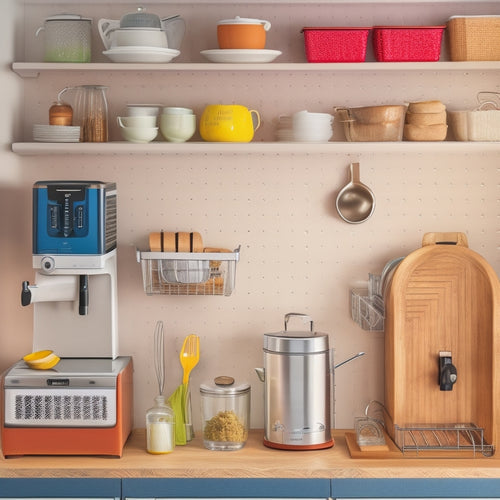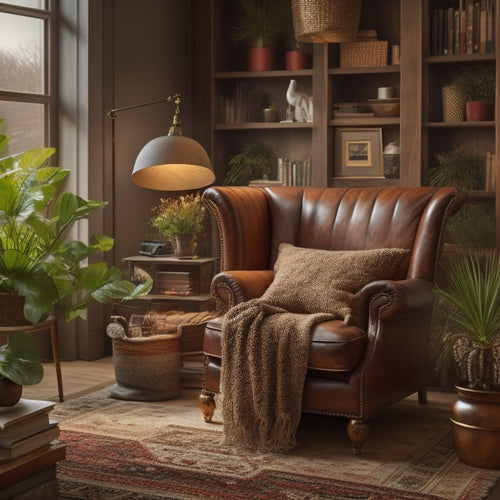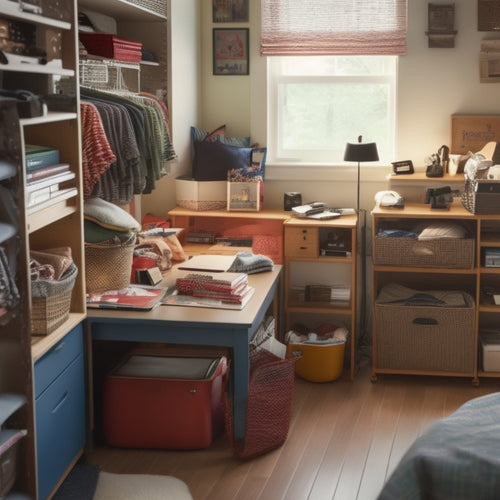
5 Quick DIY Organization Hacks for Busy Lives
Share
You can take back control of your busy life with these 5 quick DIY organization hacks. Start by committing to 10-minute daily decluttering sessions, focusing on areas that bother you most. Repurpose household items like mason jars or cardboard boxes into functional organizers. Design a morning station to streamline your daily routine, and utilize vertical space wisely with shelves, hooks, or pegboards. Finally, simplify cord management by categorizing and labeling your cables. By incorporating these hacks into your daily routine, you'll be able to reclaim precious time and reduce stress - and that's just the beginning of your organization journey.
Key Takeaways
• Commit to 10-minute daily decluttering sessions to tackle cluttered areas and focus on progress, not perfection.
• Repurpose household items like mason jars, tin cans, or cardboard boxes into functional organizers with proper labeling.
• Designate a morning station with specific spots for essentials like keys, wallet, and bags to streamline morning chaos.
• Maximize vertical space with shelves, hooks, or pegboards to keep items organized and easily accessible.
• Use cable ties and labels to simplify cord management and prevent tangling, making it easy to identify and access cables.
Decluttering in 10-Minute Batches
Start by committing to just 10 minutes a day to decluttering, and you'll be surprised at how quickly those small increments add up to a more organized space. Begin with areas that bother you the most, like your closet organization.
Set a timer, and sort clothes into three piles: keep, donate, and discard. You'll be amazed at how much you can accomplish in just 10 minutes.
Next, tackle your desk decluttering by clearing off any unnecessary papers, sorting through mail, and organizing your workspace. Remember, the goal is to make progress, not perfection.
Repurposing Household Items
By thinking creatively, you can breathe new life into items you'd otherwise toss, turning them into functional organizers that'll help you stay on top of clutter. Consider upcycling containers like old mason jars, tin cans, or cardboard boxes to create unique storage solutions.
For instance, use a mason jar to store office supplies like pens, paper clips, or pushpins. Label the jar so you can easily identify what's inside.
Think beyond traditional uses for household items. Turn an old picture frame into a jewelry organizer or use a wire hanger to store belts and scarves. You can even repurpose old furniture, like turning an old ladder into a bookshelf or using a vintage window as a room divider.
The key is to look at an item and think about how it can be used in a different way. With a little creativity, you can come up with some amazing creative storage ideas that'll help you stay organized and reduce clutter.
Creating a Morning Station
You can take your organizational skills to the next level by designing a morning station that streamlines your daily routine and gets you out the door quickly. This dedicated space will help you tackle the morning chaos and set a positive tone for the rest of the day.
Start by identifying the entryway essentials you need to grab on your way out, such as keys, wallet, and bag. Designate a specific spot for each item, like a hook for your keys and a tray for your wallet.
Next, think about your daily routine and what you need to do to get ready in the morning. Do you need a spot to charge your phone or a surface to lay out your outfit for the day? Consider incorporating a small shelf or basket to hold your morning must-haves, like coffee cups or water bottles.
Utilizing Vertical Space Wisely
Maximize your wall space by installing shelves, hooks, or a pegboard to keep frequently used items, like bags, accessories, or cleaning supplies, within easy reach and out of the way. This will free up floor space and make your daily routine more efficient.
Consider adding floating shelves to create a sleek and modern look while storing items like books, decorative objects, or kitchen utensils. You can also use hanging planters to add some greenery to your space without taking up valuable floor or counter space.
Take advantage of corners by installing carousels or lazy susans to store items like spices, cleaning supplies, or office materials. This will make it easy to access what you need without having to dig through clutter. Additionally, use adhesive hooks to hang items like keys, bags, or accessories, keeping them organized and within reach.
Simplifying Cord Management
Now that you've optimized your vertical space, it's time to tackle the often-frustrating task of cord management, where a tangled web of chargers, cables, and wires can quickly turn into a cluttered nightmare.
To simplify cord organization, start by gathering all your cables and cords and sorting them into categories, such as phone chargers, laptop cables, and earbuds. Designate a specific area, like a cord organizer or a small basket, to store each category. Use cable ties or twist ties to keep similar cords together and prevent them from getting tangled.
For added convenience, label each cord or category so you can easily identify what's what. Consider using a cord concealer or cable management box to keep cords hidden from view. This won't only declutter your space but also reduce the risk of tripping over cords or damaging them.
Frequently Asked Questions
How Do I Maintain Organization Once I've Decluttered and Organized My Space?
To maintain organization, you'll need to prioritize time management by scheduling regular tidying sessions. Invest in storage solutions like labeled bins and baskets to keep clutter at bay, and make it a habit to put things back in their designated spots.
Can I Still Be Organized if I Have a Small Living or Work Area?
You're like a master chef in a tiny kitchen, whipping up a culinary storm - yes, you can still be organized in a small living or work area, where every inch counts, and small space means big impact, even in chaos.
How Do I Involve My Family Members in Our Organization Efforts?
You involve family members in organization efforts by having open communication about goals and tasks, assigning roles to create a sense of teamwork and accountability, and setting achievable expectations to foster a sense of ownership.
Are There Specific Organization Strategies for People With Adhd?
You'll find that ADHD organization tips prioritize structure, breaking tasks into smaller chunks, and using visual reminders to boost focus and productivity; by implementing these strategies, you'll create a system that works with your unique brain, not against it.
How Often Should I Reassess and Adjust My Organization Systems?
You should regularly evaluate and adjust your organization systems, scheduling check-ins every 2-3 months to guarantee they still work for you, making tweaks as needed to maintain productivity and efficiency.
Related Posts
-

Smart Storage for Small Kitchen Appliances
You can optimize your small kitchen's functionality by implementing smart storage solutions that efficiently stash sm...
-

Budget-Friendly Ideas for a Cozy Home Library
You can transform any space into a cozy home library without breaking the bank. Start by decluttering your book colle...
-

Why College Students Need Smart Storage Systems
As you navigate the challenges of college life, you'll quickly realize that a smart storage system is essential to tr...


